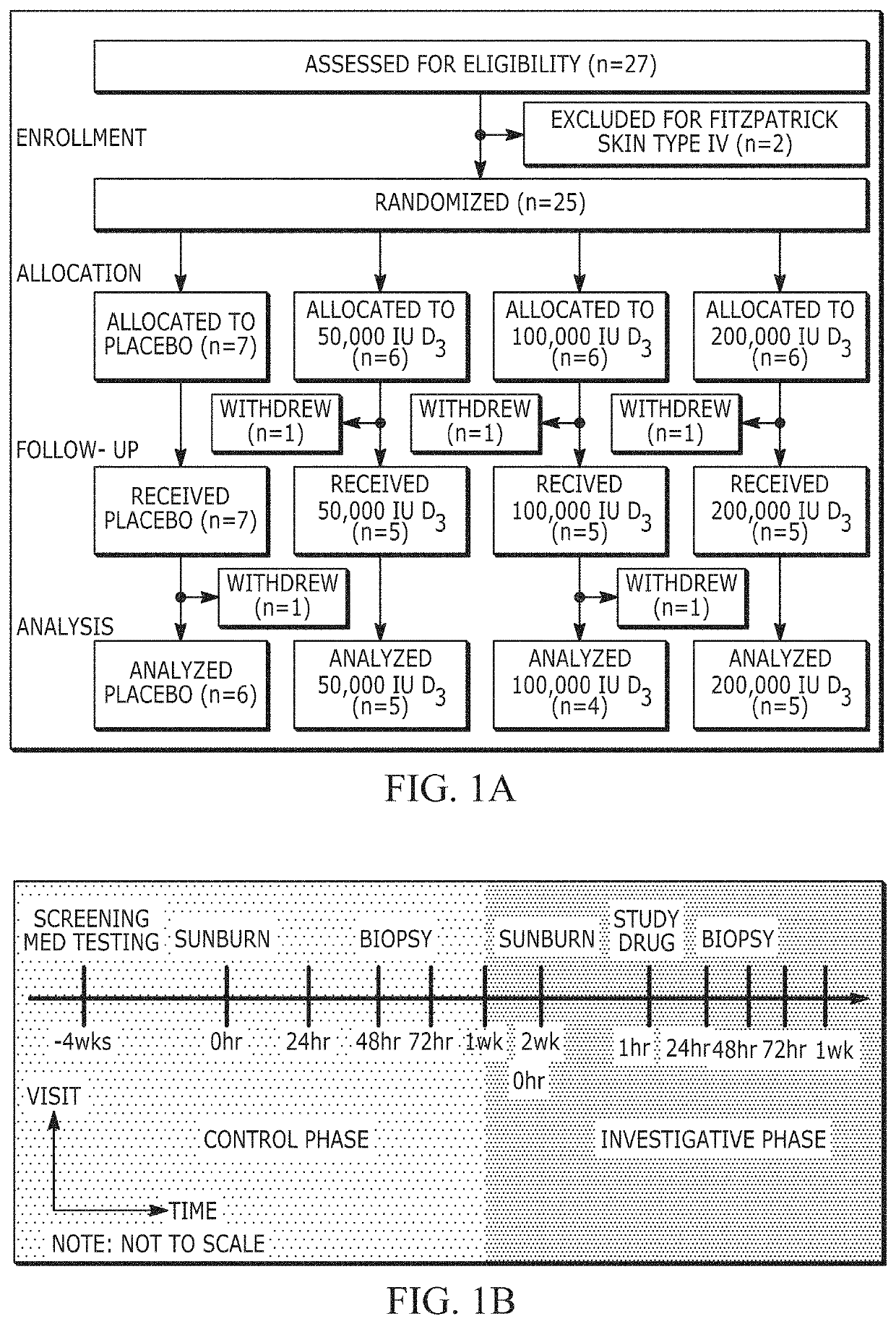Autophagy activators for treating or preventing skin injury
a technology of autophagy and skin injury, which is applied in the direction of analgesics, pharmaceutical delivery mechanisms, medical preparations, etc., can solve the problems of epidermal damage, cellular infiltration to exacerbate tissue damage, and the inability of vitamin d to modulate acute inflammation in vivo, so as to prevent excessive cutaneous damage, accelerate skin recovery, and enhance autophagy
- Summary
- Abstract
- Description
- Claims
- Application Information
AI Technical Summary
Benefits of technology
Problems solved by technology
Method used
Image
Examples
example 1
min D Rapidly Attenuates Inflammation from Sunburn
[0068]The inventors designed a pilot, proof-of-principle interventional study in humans, modeled after a randomized, double-blinded, placebo-controlled clinical trial, to test the hypothesis that a single high dose of oral vitamin D3 (cholecalciferol) would be capable of rapidly attenuating experimental sunburn induced by simulated solar radiation (SSR).
Results
[0069]Dose-Dependent Response of High Dose Oral Vitamin D3 and UV Irradiation
[0070]The randomized treatment groups did not differ in their baseline characteristics (Table 1). No participant was taking supplemental vitamin D3 before study initiation. Serum 25-hydroxyvitamin D3 (25(OH)D3), a marker of vitamin D3 stores, increased after treatment in a vitamin D3 dose-dependent fashion (FIG. 6A). Similar trends were observed for the active form of vitamin D3, 1,25(OH)2D3, as well as an inactive breakdown product, 24,25(OH)2D3 (FIG. 6B). No measured vitamin D3 metabolite increased i...
example 2
min D Attenuates Inflammation from Nitrogen Mustard
[0110]Two adults 18 years and older were screened for eligibility. The subjects were tested with topical application of nitrogen mustard in the FDA-approved form called Valchlor™ (0.016% mechlorethamine gel) for 1 hour. Results demonstrated no erythema or swelling and no altered skin sensation were observed in the study subjects over the period of 1 week. Skin biopsies at 48 hrs from each subject showed no changes on histopathology or increase in pro-inflammatory mediators by qRT-PCR. In view of these findings, a modified protocol with dose escalation exposure time and concentration of topical nitrogen mustard was developed. Six adults were then screened for eligibility and 4 were enrolled based on the new protocol of topical Valchlor exposure for 48 hours. Reaction to Valchlor™ was confirmed before the subjects were allowed to proceed with the placebo vs. Vitamin D3 intervention phase of the study.
[0111]Similar to the study describ...
example 3
Reprogramming by Vitamin D Promotes Suppression of UV-Induced Inflammation Via Macrophage Polarization
[0118]Exposure to ultra violet radiation (UVR) inflicts acute damage to the skin to initiate a cascade of inflammatory reactions that exacerbate tissue destruction resulting in delayed wound repair. The damaged epidermis generates free radicals thus exaggerating skin inflammatory response through massive infiltration of immune cells including neutrophils, DC and macrophages. So far, a myriad topical emollients and steroids have been the mainstay of current therapy for treating skin inflammation however such approaches have met with temporary success with some cases becoming increasingly refractory to steroid application with repeated use. In a murine model of chemical-induced cutaneous injury we have previously demonstrated that administration of 25(OH)D, vitamin D (VitD) IP, 1 h following nitrogen mustard exposure, was sufficient to prevent acute skin and systemic inflammation and ...
PUM
 Login to View More
Login to View More Abstract
Description
Claims
Application Information
 Login to View More
Login to View More - R&D
- Intellectual Property
- Life Sciences
- Materials
- Tech Scout
- Unparalleled Data Quality
- Higher Quality Content
- 60% Fewer Hallucinations
Browse by: Latest US Patents, China's latest patents, Technical Efficacy Thesaurus, Application Domain, Technology Topic, Popular Technical Reports.
© 2025 PatSnap. All rights reserved.Legal|Privacy policy|Modern Slavery Act Transparency Statement|Sitemap|About US| Contact US: help@patsnap.com



